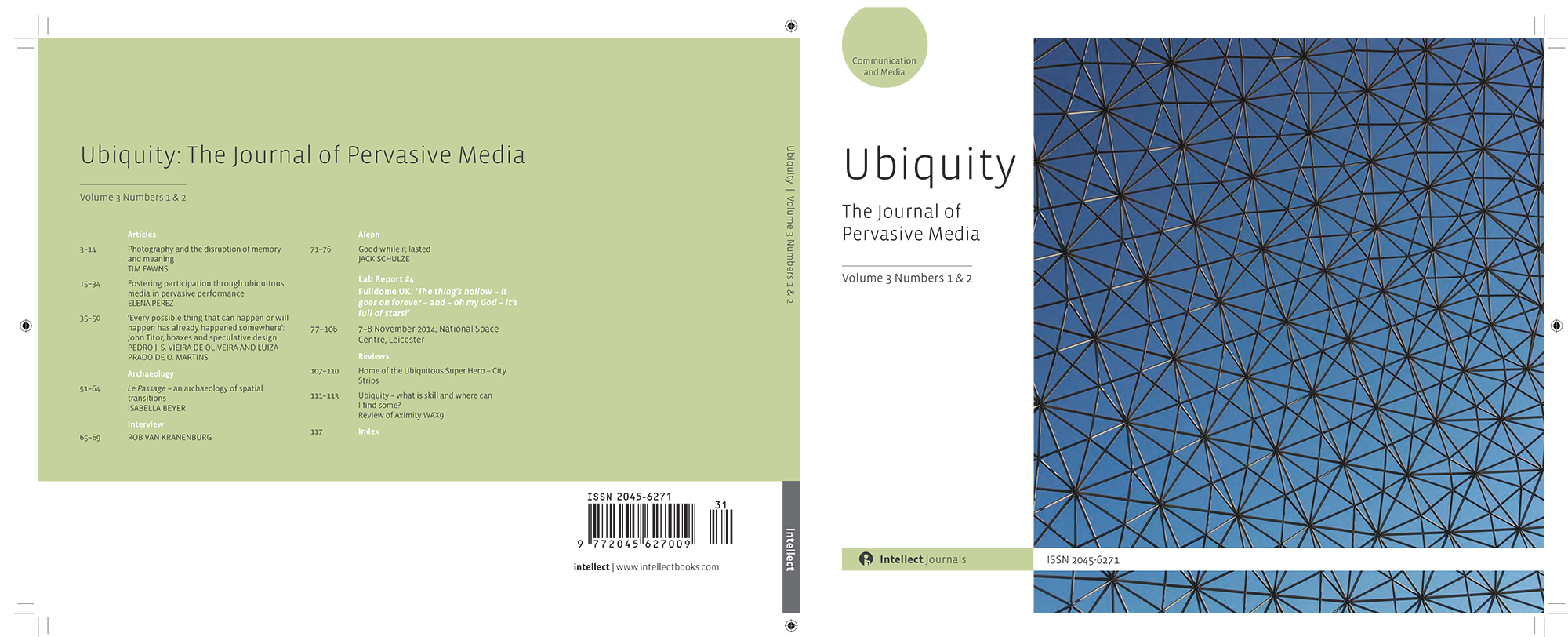THE ATEMPORAL IMAGE PUBLICATION.
ISSN: 20456271
Online ISSN: 2045628X
Full paper deadline: 10 August 2016 (revised date).
Author Guidelines (PDF version)
Email abstracts to: transimage2016@gmail.com
Following the conference presentations authors are invited to submit Full Papers for inclusion in Ubiquity: The Journal of Pervasive Media, published by Intellect Ltd. [free issue here]
Please observe the following strict author guidelines. Full Paper submissions will be submitted for review and copy-edit, required alterations will be returned to the author for amendments. This will need to take place within a time frame defined by the Editors and Intellect.
AUTHOR GUIDELINES:
[Please see the House Style Guidelines for more detailed information.]METADATA:
All articles must include the following metadata:
- title
- name of author
- abstract
- keywords
- main text: 3000-4000 words
- full references list at the end
- short author biography
- author street address
- e-mail address
STRUCTURE:
Font: Arial, 12 point Single line spacing
Alignment: left justified.
Paragraphs: single line between.
Subtitles: caps and lower case letters. bold.
Name of author: caps and lower case letters. Bold.
Institutional affiliation: caps and lower case letters.
Title of paper: caps and lower case letters. Bold.
Abstract: approx 100-200 words. It should describe the paper succinctly, considering search services.
Keywords: Six to eight words or two-word phrases. Lower case (unless they are proper nouns).
Main text:
- 3000-4000 words
- Arial, 12 point.
- Single line spacing,
- left justified,
- single line between paragraphs.
- Subtitles in caps and lower case letters in bold.
- Endnotes not footnotes.
References: Harvard references embedded in the main text in the following format (Harper 1999: 27), and a single bibliography at the end of the article (see style guide).
Author biography: aprox 100-200 words.
Author street address: institutional postal address.
E-mail address: institutional email address.
FILE FORMATS:
- Please use only the following file type when sending your paper: Microsoft Word (PC or Mac).
- Include your family name in the title of the document (Example – Bloggs.doc).
- Other file types will be returned for re-submission. This includes pdfs.
IMAGES:
High quality images at 300 dpi (max page size 23cm x 17.4cm or double at 46cm x 17.4cm) can be incorporated as .png, .tiff, .jpg.
Colour images will be available in the digital version with a restricted number in the hard copy print version. The print colour selection will be made by the editors.
Image Copyright:
It is the author’s responsibility to obtain written permission from copyright holders for reproducing any images, tables or figures that have previously been published elsewhere. Copyright permissions must be obtained before the article is published or there is a risk of copyright infringement. Failure to procure these rights could result in a delay in article publication. Intellect Image Copyright Form:
[chrome-extension://gbkeegbaiigmenfmjfclcdgdpimamgkj/views/app.html]
HOUSE STYLE:
The Fourth International Conference on Transdisciplinary Imaging at the Intersections of Art, Science and Culture 2016, will be using Intellect Publishing House Style guide:
http://www.intellectbooks.co.uk/MediaManager/File/style%20guide(journals)-1.pdf.
Additional Author Resources:
http://www.intellectbooks.co.uk/page/index,name=journalresources/
AUTHOR CONSENT FORM:
All authors need to complete the Intellect Author Consent Form once the editing process is complete, before the paper can be published.
THE ATEMPORAL IMAGE:
Our contemporary quotidian lives are becoming increasingly indebted to virtual platforms for social exchange and cultural mediation. The ubiquity of social media has necessitated the birth of virtual graveyards; frozen digital reliquaries marking the cessation of our online busywork. Museums and culture conservationists are hurriedly digitising material fragments of the Anthropocene in an anxious contest against time and entropy. In this world the family photo-album is no longer an object but a well pool of dematerialised data.
- To what extent has time’s unrelenting persecution of matter and, by historical virtue of necessity, culture, been circumvented in the digital age?
- What is time to the dematerialised image?
- Does the cloud and distributed data networks shift the agency of time as it shifts the image?
- Has the duration of the gaze been supplanted by a sequence of fleeting glances as the mechanics of our biological bodies struggle clumsily to fix upon a new frenetic landscape of hypermediated imagery?
The figurative freezing of digital data is a far cry from the corporeal terminus we have historically conceived of as death. In its epitaphic state even the digital graveyard is full of life; of reading, relaying and revival. Even these (a)temporarily static fields of data serve to nourish a complex bio-digital ecology that decomposes, blooms and flourishes in a new non-terrestrial time, unbound by the phenomenal cycles of the stars. The age of information has given rise to a new breed of temporality whereby nothing ever dies but is only defrag’d, retrieved, restored and remixed. The Transdisciplinary Imaging Conference is calling for papers that explore how this new temporality informs and plays out across contemporary visual culture.
Participants are asked to address aspects of the atemporal at least one of the following areas:
- the still image
- the immersive image
- the sound as image
- hypermediacy and the iconic character of the image
- politics of the image and/or image making in a transdisciplinary context
- life sciences and bioart in relation to the living image
- distributed and networked image
- The trans-scalar image(inary), from the nano to the astronomical image
- Artificial and computer vision
- moving still
- image as time, real-time and glitch-time
- archival, permanency and immediacy
- aesthetics and proliferation of the image
The conference invites papers that respond to the above provocation in areas related to: Media Arts, Painting, Drawing, Curating, Installation, Film, Video, Photography, Computer/data Visualization/sonification, Real-time Imaging, Intelligent Systems and Image Science.


